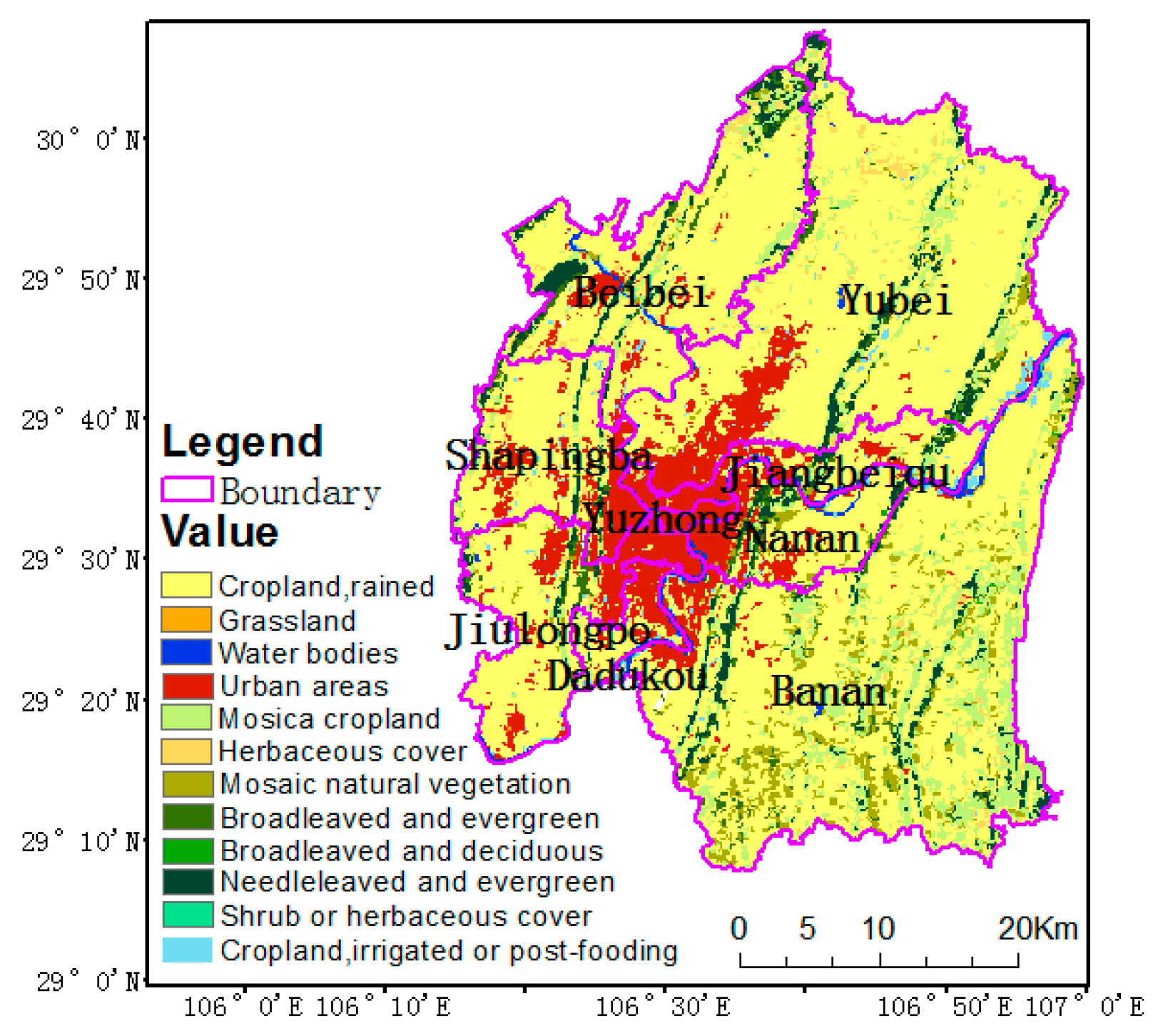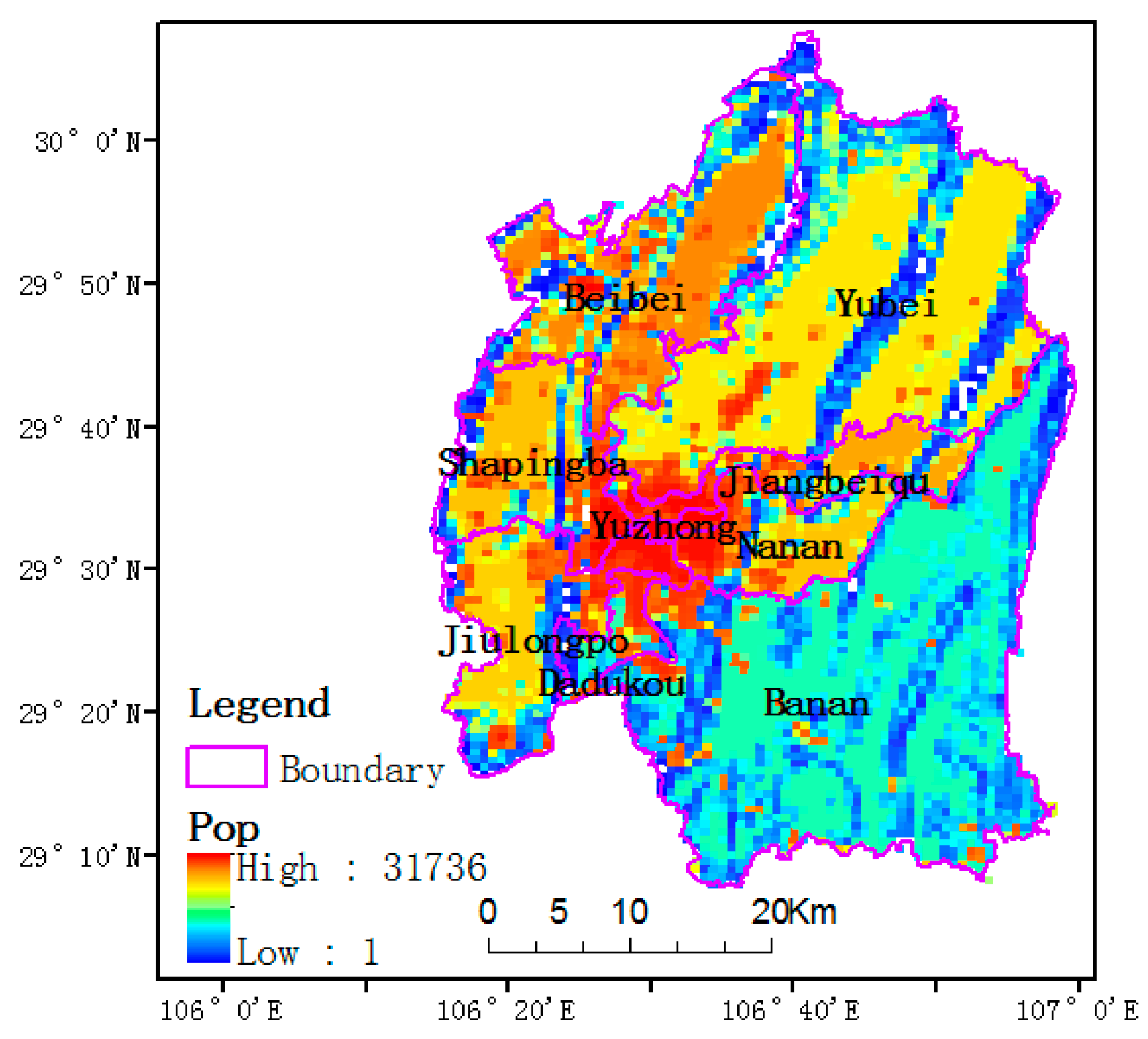Estimation of Ground-Level PM2.5 Concentrations in the Major Urban Areas of Chongqing by Using FY-3C/MERSI
Abstract
:1. Introduction
2. Data and Methodology
2.1. Study Area
2.2. Data
2.2.1. Satellite-Retrieved AOD Data
2.2.2. In Situ PM2.5
2.2.3. Meteorological Data
2.2.4. Auxiliary Data
2.3. The Combined Mixed Effect Model
2.3.1. Model Description
2.3.2. Model Validation
3. Results and Discussion
3.1. Statistical Analysis
3.2. Model Fitting and Validation
3.3. Spatial Distribution of Estimated PM2.5
4. Conclusions
Acknowledgments
Author Contributions
Conflicts of Interest
References
- Bell, M.L.; Keita, E.; Kathleen, B. Ambient Air Pollution and Low Birth Weight in Connecticut and Massachusetts. Environ. Health Perspect. 2007, 115, 1118–1124. [Google Scholar] [CrossRef] [PubMed]
- Dominici, F.; Peng, R.D.; Bell, M.L.; Pham, M.L.; Mcdermott, A.; Zeger, S.L.; Samet, J.M. Fine particulate air pollution and hospital admission for cardiovascular and respiratory diseases. J. Am. Med. Assoc. 2006, 295, 1127–1134. [Google Scholar] [CrossRef] [PubMed]
- Slama, R.; Morgenstern, V.; Cyrys, J.; Zutavern, A.; Herbarth, O.; Wichmann, H.E.; Heinrich, J.; Group, T.L.S. Traffic-related atmospheric pollutants levels during pregnancy and offspring’s term birth weight: A study relying on a land-use regression exposure model. Environ. Health Perspect. 2007, 115, 1283–1292. [Google Scholar] [CrossRef] [PubMed]
- Hutchison, K.D. Applications of MODIS satellite data and products for monitoring air quality in the state of Texas. Atmos. Environ. 2003, 37, 2403–2412. [Google Scholar] [CrossRef]
- Falke, S.R.; Husar, R.B.; Schichtel, B.A. Fusion of SeaWIFS and TOMS satellite data with surface observations and topographic data during extreme aerosol events. J. Air Waste Manag. Assoc. 2001, 51, 1579–1585. [Google Scholar] [CrossRef] [PubMed]
- Van Donkelaar, A.; Martin, R.V.; Brauer, M.; Boys, B.L. Use of satellite observations for long-term exposure assessment of global concentrations of fine particulate matter. Environ. Health Perspect. 2015, 123, 135–143. [Google Scholar] [CrossRef] [PubMed]
- Liu, Y. New directions: Satellite driven PM2.5 exposure models to support targeted particle pollution health effects research. Atmos. Environ. 2013, 68, 52–53. [Google Scholar] [CrossRef]
- Liu, Y. Monitoring PM2.5 from space for health: Past, present, and future directions. Environ. Manag. 2014, 6, 6–10. [Google Scholar]
- Chu, D.A.; Tsai, T.C.; Chen, J.P.; Chang, S.C.; Jeng, Y.J.; Chiang, W.L.; Lin, N.H. Interpreting aerosol LiDAR profiles to better estimate surface PM2.5 for columnar AOD measurements. Atmos. Environ. 2013, 79, 172–187. [Google Scholar] [CrossRef]
- Zhang, Y.; Li, Z. Remote sensing of atmospheric fine particulate matter (PM2.5) mass concentration near the ground from satellite observation. Remote Sens. Environ. 2015, 160, 252–262. [Google Scholar] [CrossRef]
- Wang, J. Intercomparison between satellite-derived aerosol optical thickness and PM2.5 mass: Implications for air quality studies. Geophys. Res. Lett. 2003, 30, 2029. [Google Scholar] [CrossRef]
- Hoff, R.M.; Christopher, S.A. Remote sensing of particulate pollution from space: Have we reached the promised land? J. Air Waste Manag. Assoc. 2009, 59, 645–675. [Google Scholar] [PubMed]
- Lee, H.J.; Liu, Y.; Coull, B.A.; Schwartz, J.; Koutrakis, P. A novel calibration approach of modis AOD data to predict PM2.5 concentrations. Atmos. Chem. Phys. 2011, 11, 9769–9795. [Google Scholar] [CrossRef]
- Hu, X.; Waller, L.A.; Al-Hamdan, M.Z.; Crosson, W.L.; Estes, M.G.; Estes, S.M.; Quattrochi, D.A.; Sarnat, J.A.; Liu, Y. Estimating ground-level PM2.5 concentrations in the southeastern U.S. using geographically weighted regression. Environ. Res. 2013, 121, 1–10. [Google Scholar] [CrossRef] [PubMed]
- Liu, Y.; Sarnat, J.A.; Kilaru, V.; Jacob, D.J.; Koutrakis, P. Estimating ground-level PM2.5 in the eastern united states using satellite remote sensing. Environ. Sci. Technol. 2005, 39, 3269–3278. [Google Scholar] [CrossRef] [PubMed] [Green Version]
- Liu, Y.; Paciorek, C.J.; Koutrakis, P. Estimating regional spatial and temporal variability of PM2.5 concentrations using satellite data, meteorology, and land use information. Environ. Health Perspect. 2009, 117, 886–892. [Google Scholar] [CrossRef] [PubMed] [Green Version]
- Hu, X.; Waller, L.A.; Lyapustin, A.; Wang, Y.; Liu, Y. Improving satellite-driven PM2.5 micrometer models with moderate resolution imaging spectroradiometer fire counts in the southeastern U.S. J. Geophys. Res. Atmos. 2014, 119. [Google Scholar] [CrossRef] [PubMed]
- Song, W.; Jia, H.; Huang, J.; Zhang, Y. A satellite-based geographically weighted regression model for regional PM2.5 estimation over the Pearl River Delta region in China. Remote Sens. Environ. 2014, 154, 1–7. [Google Scholar] [CrossRef]
- You, W.; Zang, Z.; Zhang, L.; Li, Y.; Pan, X.; Wang, W. National-scale estimates of ground-level PM2.5 concentration in China using geographically weighted regression based on 3 km resolution modis AOD. Remote Sens. 2016, 8, 184. [Google Scholar] [CrossRef]
- Li, S.; Joseph, E.; Min, Q. Remote sensing of ground-level PM2.5 combining AOD and backscattering profile. Remote Sens. Environ. 2016, 183, 120–128. [Google Scholar] [CrossRef]
- Remer, L.A.; Kaufman, Y.J.; Tanré, D.; Mattoo, S.; Chu, D.A.; Martins, J.V.; Li, R.-R.; Ichoku, C.; Levy, R.C.; Kleidman, R.G.; et al. The MODIS aerosol algorithm, products, and validation. J. Atmos. Sci. 2005, 62, 947–973. [Google Scholar] [CrossRef]
- Deng, Y.; Hu, M.; Lin, C.; Cao, J. Analysis on the air quality status and meteorological condition of Chongqing urban area in 2015. Sichuan Environ. 2016, 42, 61–66. (In Chinese) [Google Scholar]
- Ge, Q.; Hu, Y.; Zhang, L.; Zhang, S. Retrieval of aerosol over land surface from FY-3C/MERSI with DDV algorithm. Remote Sens. Inf. 2017, 32, 34–38. [Google Scholar]
- Teng, W. Retrieval of Aerosol over Beijing and Sorround Using MERSI and MODIS Data. Master’s Thesis, Capital Normal University, Beijing, China, 2013. (In Chinese). [Google Scholar]
- Zhou, Y.; Bai, J.; Zhou, Z.; Qi, L. Aerosol optical depth retrieval from FY-3A/MERSI for sand-dust weather over ocean. J. Remote Sens. 2014, 18, 771–787. [Google Scholar]
- Kaufman, Y.J.; Tanré, D.; Remer, L.A.; Vermote, E.F.; Chu, A.; Holben, B.N. Operational remote sensing of tropospheric aerosol over land from EOS moderate resolution imaging spectroradiometer. J. Geophys. Res. Atmos. 1997, 102, 17051–17067. [Google Scholar] [CrossRef]
- Hu, X.; Waller, L.A.; Lyapustin, A.; Wang, Y.; Al-Hamdan, M.Z.; Crosson, W.L.; Estes, M.G.; Estes, S.M.; Quattrochi, D.A.; Puttaswamy, S.J.; et al. Estimating ground-level PM2.5 concentrations in the southeastern united states using MAIAC AOD retrievals and a two-stage model. Remote Sens. Environ. 2014, 140, 220–232. [Google Scholar] [CrossRef]
- OuYang, S. Summarization on PM2.5 online monitoring technique. China Environ. Prot. Ind. 2012, 4, 14–18. (In Chinese) [Google Scholar]
- Liu, Y.; Franklin, M.; Kahn, R.; Koutrakis, P. Using aerosol optical thickness to predict ground-level PM2.5 concentrations in the St. Louis area: A comparison between MISR and MODIS. Remote Sens. Environ. 2007, 107, 33–44. [Google Scholar] [CrossRef]
- Gupta, P.; Christopher, S.A.; Wang, J.; Gehrig, R.; Lee, Y.; Kumar, N. Satellite remote sensing of particulate matter and air quality assessment over global cities. Atmos. Environ. 2006, 40, 5880–5892. [Google Scholar] [CrossRef]
- Barman, S.C.; Singh, R.; Negi, M.P.S.; Bhargava, S.K. Fine particles (PM2.5) in residential areas of lucknow city and factors influencing the concentration. CLEAN Soil Air Water 2010, 36, 111–117. [Google Scholar] [CrossRef]
- Pateraki, S.; Asimakopoulos, D.N.; Flocas, H.A.; Maggos, T.; Vasilakos, C. The role of meteorology on different sized aerosol fractions (PM10, PM2.5, PM2.5–10). Sci. Total Environ. 2012, 419, 124–135. [Google Scholar] [CrossRef] [PubMed]
- Liu, Y.; Chen, P.Q.; Zhang, W.; Hu, F. A spatial interpolation method for surface air temperature and its error analysis. Chin. J. Atmos. Sci. 2006, 30, 146–152. (In Chinese) [Google Scholar]
- Tang, G.A.; Zhao, M.D.; Yang, X.; Zhou, Y. Geographic Information System; Science Press: Beijing, China, 2002. [Google Scholar]
- Jiang, X.J.; Liu, X.J.; Huang, F.; Jiang, H.Y.; Cao, W.X.; Zhu, Y. Comparison of spatial interpolation methods for daily meteorological elements. Chin. J. Appl. Ecol. 2010, 21, 624–630. (In Chinese) [Google Scholar]
- Zheng, Z.; Chen, L.; Zheng, J.; Zhong, L. Application of retrieved high-resolution AOD in regional pm monitoring in the pearl river delta and Hong Kong region. Acta Sci. Circumst. 2011, 31, 1154–1161. [Google Scholar]
- Chin, M. Tropospheric aerosol optical thickness from the gocart model and comparisons with satellite and sun photometer measurements. J. Atmos. Sci. 2002, 59, 461–483. [Google Scholar] [CrossRef]
- Li, S.L. Density of population, industrial structure and quality of urbanization. Commer. Res. 2014, 12, 61–67. [Google Scholar]
- Tian, J.; Chen, D. A semi-empirical model for predicting hourly ground-level fine particulate matter (PM2.5) concentration in southern Ontario from satellite remote sensing and ground-based meteorological measurements. Remote Sens. Environ. 2010, 114, 221–229. [Google Scholar] [CrossRef]
- Malm, W.C.; Day, D.E.; Kreidenweis, S.M. Light scattering characteristics of aerosols as a function of relative humidity: Part I—A comparison of measured scattering and aerosol concentrations using the theoretical models. J. Air Waste Manag. Assoc. 2000, 50, 686–700. [Google Scholar] [CrossRef] [PubMed]
- Ma, Z. Study on Spatiotemporal Distributions of PM2.5 in China Using Satellite Remote Sensing. Ph.D. Thesis, Nanjing University, Nanjing, China, 2015. (In Chinese). [Google Scholar]
- Chen, Y.; Xie, S.; Luo, B.; Zhai, C. Pollution characterization and source apportionment of fine particles in urban Chongqing. Acta Sci. Circumst. 2017, 37, 2420–2430. (In Chinese) [Google Scholar]









| Variable | Unit | Description |
|---|---|---|
| AOD | Unit less | FY-3C MERSI AOD |
| TMP | °C | Temperature |
| WS | m/s | Wind Speed |
| RH | % | Relative humidity |
| PS | hPa | Surface pressure |
| ELEV | m | Elevation |
| Pop | Ten thousand/km2 | Population density |
| α | Unit less | Fixed effects intercept |
| ω | Unit less | Random effects intercept |
| β1–β5 | Unit less | Fixed effects slope |
| u1–u5 | Unit less | Random effects slope |
| ε | Unit less | Random errors |
| Name | Parameters | Model I (All Data) | Model II (All Data) | Model II (Warm) | Model II (Cold) |
|---|---|---|---|---|---|
| Fitting | N | 1106 | 1106 | 838 | 268 |
| R2 | 0.89 | 0.90 | 0.81 | 0.92 | |
| RMSE (μg/m3) | 12.27 | 11.41 | 9.17 | 13.51 | |
| MPE (μg/m3) | 7.85 | 7.62 | 6.37 | 10.43 | |
| CV | R2 | 0.85 | 0.87 | 0.79 | 0.88 |
| RMSE (μg/m3) | 13.72 | 12.09 | 9.73 | 15.86 | |
| RMSE (μg/m3) | 9.17 | 8.92 | 7.48 | 13.51 |
© 2017 by the authors. Licensee MDPI, Basel, Switzerland. This article is an open access article distributed under the terms and conditions of the Creative Commons Attribution (CC BY) license (http://creativecommons.org/licenses/by/4.0/).
Share and Cite
Zeng, Q.; Wang, Z.; Tao, J.; Wang, Y.; Chen, L.; Zhu, H.; Yang, J.; Wang, X.; Li, B. Estimation of Ground-Level PM2.5 Concentrations in the Major Urban Areas of Chongqing by Using FY-3C/MERSI. Atmosphere 2018, 9, 3. https://doi.org/10.3390/atmos9010003
Zeng Q, Wang Z, Tao J, Wang Y, Chen L, Zhu H, Yang J, Wang X, Li B. Estimation of Ground-Level PM2.5 Concentrations in the Major Urban Areas of Chongqing by Using FY-3C/MERSI. Atmosphere. 2018; 9(1):3. https://doi.org/10.3390/atmos9010003
Chicago/Turabian StyleZeng, Qiaolin, Zifeng Wang, Jinhua Tao, Yongqian Wang, Liangfu Chen, Hao Zhu, Jie Yang, Xinhui Wang, and Bin Li. 2018. "Estimation of Ground-Level PM2.5 Concentrations in the Major Urban Areas of Chongqing by Using FY-3C/MERSI" Atmosphere 9, no. 1: 3. https://doi.org/10.3390/atmos9010003




